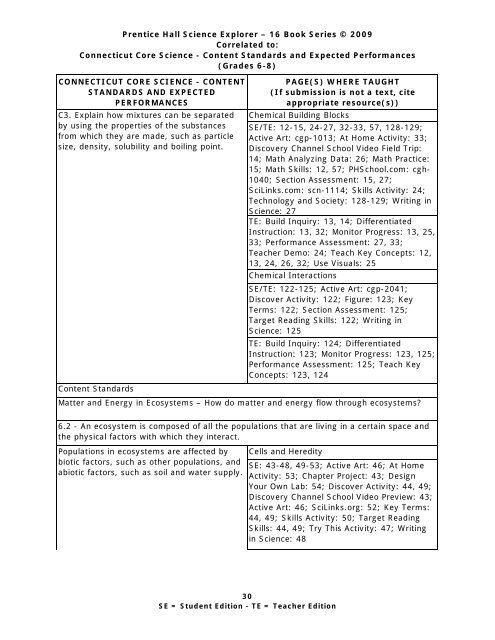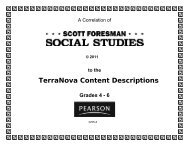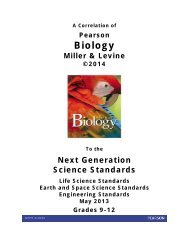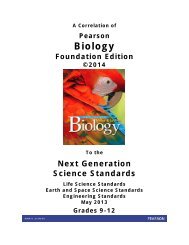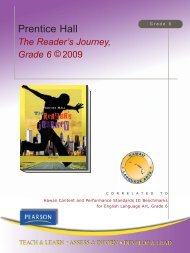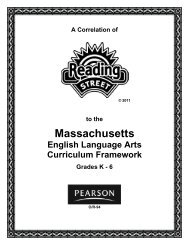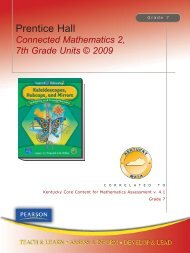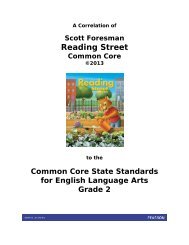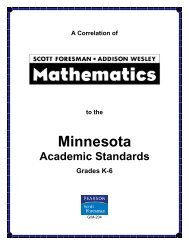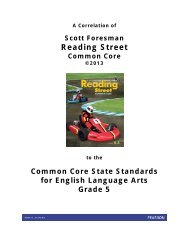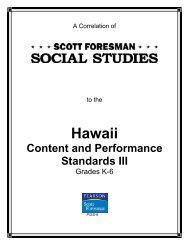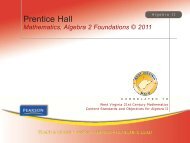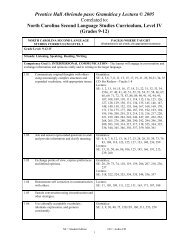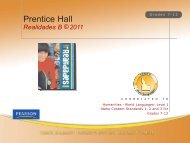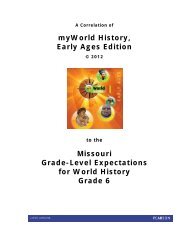Prentice Hall Science Explorer â 16 Book Series © 2009 ... - Pearson
Prentice Hall Science Explorer â 16 Book Series © 2009 ... - Pearson
Prentice Hall Science Explorer â 16 Book Series © 2009 ... - Pearson
Create successful ePaper yourself
Turn your PDF publications into a flip-book with our unique Google optimized e-Paper software.
<strong>Prentice</strong> <strong>Hall</strong> <strong>Science</strong> <strong>Explorer</strong> – <strong>16</strong> <strong>Book</strong> <strong>Series</strong> © <strong>2009</strong><br />
Correlated to:<br />
Connecticut Core <strong>Science</strong> - Content Standards and Expected Performances<br />
(Grades 6-8)<br />
CONNECTICUT CORE SCIENCE - CONTENT<br />
STANDARDS AND EXPECTED<br />
PERFORMANCES<br />
C3. Explain how mixtures can be separated<br />
by using the properties of the substances<br />
from which they are made, such as particle<br />
size, density, solubility and boiling point.<br />
PAGE(S) WHERE TAUGHT<br />
(If submission is not a text, cite<br />
appropriate resource(s))<br />
Chemical Building Blocks<br />
SE/TE: 12-15, 24-27, 32-33, 57, 128-129;<br />
Active Art: cgp-1013; At Home Activity: 33;<br />
Discovery Channel School Video Field Trip:<br />
14; Math Analyzing Data: 26; Math Practice:<br />
15; Math Skills: 12, 57; PHSchool.com: cgh-<br />
1040; Section Assessment: 15, 27;<br />
SciLinks.com: scn-1114; Skills Activity: 24;<br />
Technology and Society: 128-129; Writing in<br />
<strong>Science</strong>: 27<br />
TE: Build Inquiry: 13, 14; Differentiated<br />
Instruction: 13, 32; Monitor Progress: 13, 25,<br />
33; Performance Assessment: 27, 33;<br />
Teacher Demo: 24; Teach Key Concepts: 12,<br />
13, 24, 26, 32; Use Visuals: 25<br />
Chemical Interactions<br />
SE/TE: 122-125; Active Art: cgp-2041;<br />
Discover Activity: 122; Figure: 123; Key<br />
Terms: 122; Section Assessment: 125;<br />
Target Reading Skills: 122; Writing in<br />
<strong>Science</strong>: 125<br />
TE: Build Inquiry: 124; Differentiated<br />
Instruction: 123; Monitor Progress: 123, 125;<br />
Performance Assessment: 125; Teach Key<br />
Concepts: 123, 124<br />
Content Standards<br />
Matter and Energy in Ecosystems – How do matter and energy flow through ecosystems<br />
6.2 - An ecosystem is composed of all the populations that are living in a certain space and<br />
the physical factors with which they interact.<br />
Populations in ecosystems are affected by<br />
biotic factors, such as other populations, and<br />
abiotic factors, such as soil and water supply.<br />
Cells and Heredity<br />
SE: 43-48, 49-53; Active Art: 46; At Home<br />
Activity: 53; Chapter Project: 43; Design<br />
Your Own Lab: 54; Discover Activity: 44, 49;<br />
Discovery Channel School Video Preview: 43;<br />
Active Art: 46; SciLinks.org: 52; Key Terms:<br />
44, 49; Skills Activity: 50; Target Reading<br />
Skills: 44, 49; Try This Activity: 47; Writing<br />
in <strong>Science</strong>: 48<br />
30<br />
SE = Student Edition - TE = Teacher Edition


